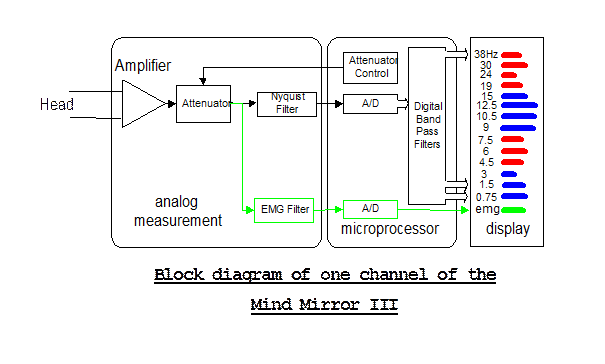Mind Mirror Vilistus
The Mind Mirror V (or Vilistus) implements the Cade/Blundell band pass filters.
Please contact Judith Pennington for availability, or search for country specific sites on the internet.
Mind Mirror Infinity
The Mind Mirror Infinity implements the Cade/Blundell band pass filters on the Thought Technology's BioGraph Infinity package.
Please contact Judith Pennington for availability.
Mind Mirror - Cade/Blundel Filter defintions
The Mind Mirror is used to define a specific method analysing EEG - these are called the Cade/Blundell Band Pass filters. These filters analyze in realtime per the following table
The Cade Blundell Filter specifications implemented in the Mind Mirror III (designed in 1992) are
|
Frequency |
Stop 1 Cutoff |
Pass 1 Cutoff |
Pass 2 Cutoff |
Stop 2 Cutoff |
ripple/ att. |
|
�0.75 |
0.12 |
�0.5 |
�1.0 |
2.5 |
3/40 |
|
�1.5 |
0.2 |
�1.1 |
�2.3 |
9.1 |
3/40 |
|
�3.0 |
0.55 |
�2.3 |
�3.7 |
10.5 |
3/40 |
|
�4.5 |
�1.1 |
�3.7 |
5.25 |
12.0 |
3/40 |
|
�6.0 |
�1.8 |
5.25 |
6.8 |
12.0 |
3/40 |
|
�7.5 |
�3.3 |
�6.8 |
�7.9 |
11.8 |
3/40 |
|
�9.0 |
�3.6 |
�7.9 |
�9.5 |
17.3 |
3/40 |
|
10.5 |
�4.2 |
�9.5 |
11.5 |
21.1 |
3/40 |
|
12.5 |
�5.5 |
11.5 |
13.5 |
22.0 |
3/40 |
|
�15 |
�4.9 |
13.5 |
17.0 |
31.9 |
3/40 |
|
�19 |
�5.5 |
17.0 |
21.5 |
31.9 |
3/40 |
|
�24 |
�8 |
21.5 |
27.0 |
50.0 |
3/40 |
|
�30 |
13.5 |
27.0 |
34.0 |
50.0 |
3/40 |
|
�38 |
17.0 |
34.0 |
44.0 |
50.0 |
1/40 |
(We would be happy to supply the Filter coefficents)
The 0.75Hz filter is a Butterworth filter with a group delay of
2.1 Seconds at 0.5Hz
1.2 seconds at 1.0Hz
The other filters are Bessel filters, with group delays of better than 1 second.
The delay of the low frequency filters has been optimised to be as small as possible to indicate as fast as possible the detection of that frequency.
The digital output of the filter is fed into a peak detect circuitry such that it remains visible to the eyes for 0.5second, even when it may be very fast such as in the 38Hz band

EEG Inputs from the scalp
The inputs are floating low noise differential inputs. They are AC coupled
to prevent any DC voltages from affecting the output. A separate ground lead
is supplied to ensure the body and the instrument are at the same potential.
The inputs may be switched, under user control to reference the ground lead.